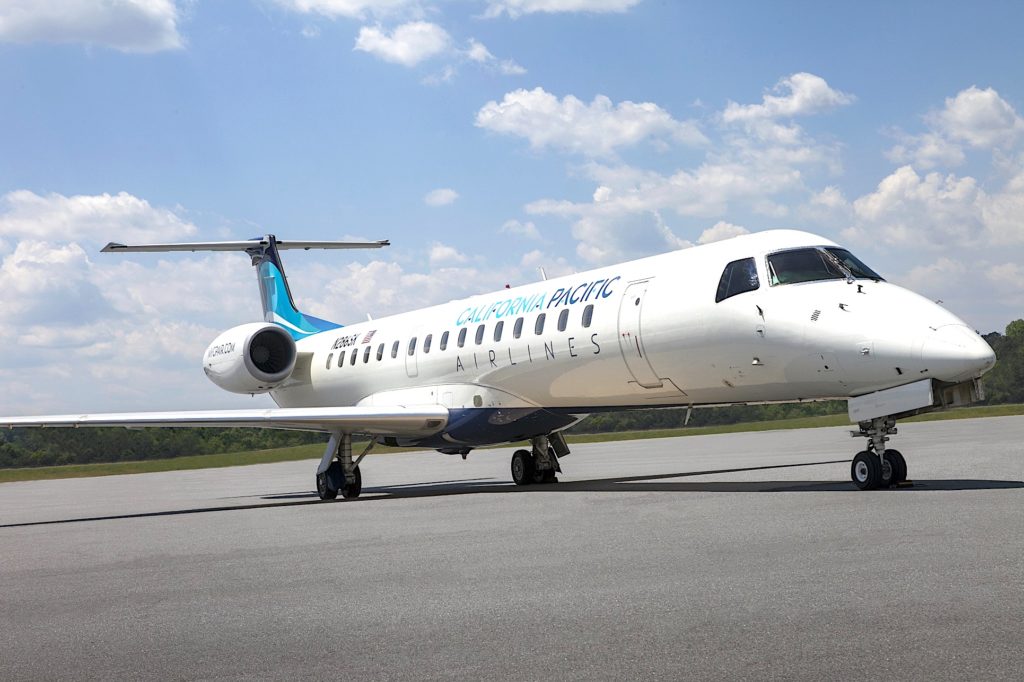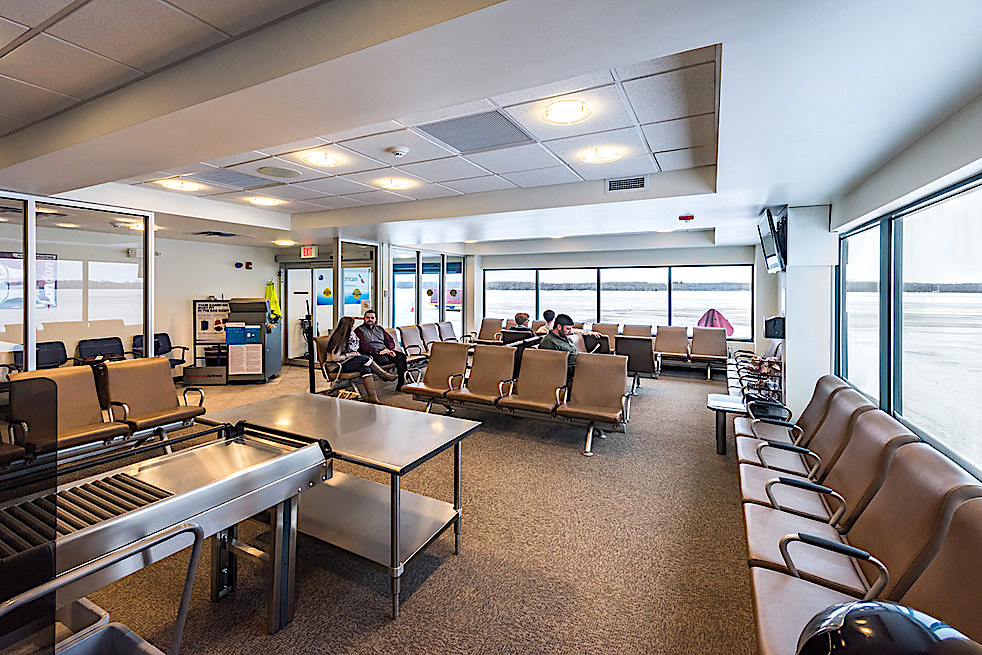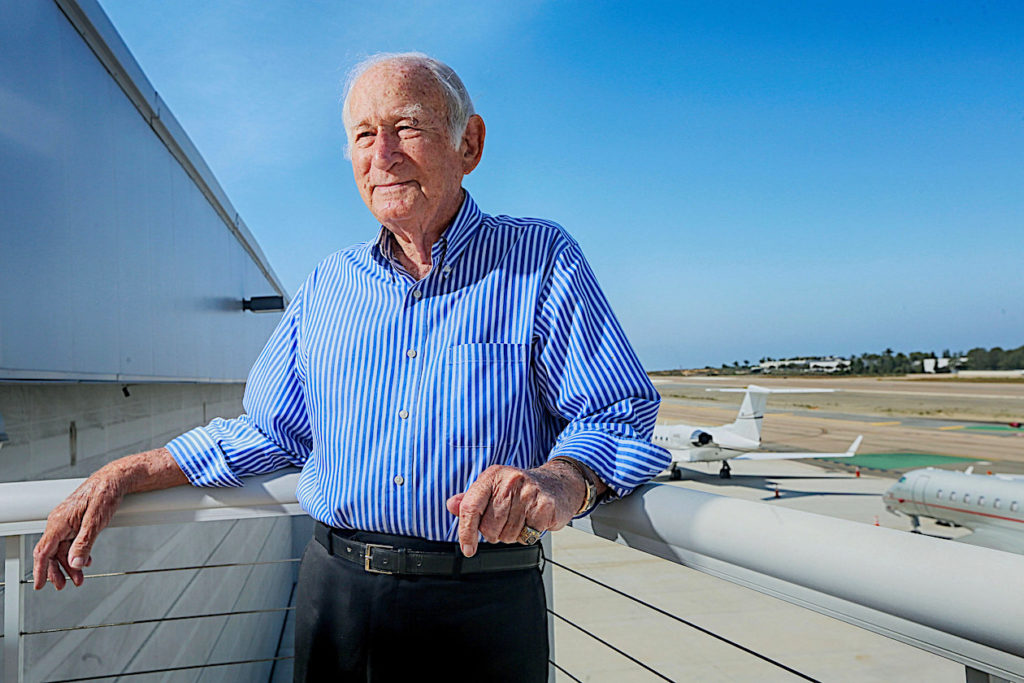Like the Black Knight in “Monty Python and the Holy Grail,” who kept on fighting despite being torn apart limb by limb, California Pacific Airlines chief Ted Vallas said Tuesday his troubled 10-year airline project would fly again “within three months.”
California Pacific Airlines flew for one month last year, incurred large debts, grounded its airplane, left employees without payments, got kicked out of the state of South Dakota, stiffed airports and creditors, and was sued by its former head mechanic for violating safety rules and wrongful termination..
Contacted late Tuesday at his Moonlight Beach, Encinitas home, Vallas, who turns 98 in March, added: “We have signed contracts from a venture capital company for a great program with fresh aircraft, fresh money, fresh personnel in all phases. This is in the millions of dollars, but we have a non-disclosure agreement as to the amount.”
Vallas could not name the financial company coming to CP Air’s rescue, however, saying the company would send out a news release sometime Wednesday. An advance copy of the news release disclosed by another news source Tuesday said CP Air expected up to $38 million in new investment and a $12 million line of credit.
However, Vallas has a history of statements that don’t come to fruition. In 2016, he announced that the airline would start operations in four months. However, officials with San Diego County, said at the time it had rejected its most-recent application and could take up to two years to do an environmental review.
A similar situation happened in 2013 when Vallas and a new executive officer said it could get the airline operational by the end of the year. In 2010, Vallas said he was planning to get the airline off the ground by 2012.
When last we left

This Embraer jet leased by California Pacific Airlines — and just painted and re-branded from Aerodynamics Inc., in August — won’t be seen over Carlsbad and Pierre anymore. Federal officials announced Friday, Jan. 18, that CPAir informed them on Friday the McClellan-Palomar Airport-based company is done flying people from Pierre and Watertown, South Dakota, to Denver./ California Pacific Airlines
California Pacific Airlines, launched flights on Nov. 1 last year from Carlsbad’s McClellan-Palomar Airport to San Jose, only to halt service in late December, citing a nationwide pilot shortage. The airline operated either one or two Embraer SA E145 aircraft — the number is in dispute — and had planned to complete additional pilot training in January and resume service, according to Bloomberg News.
The carrier, which had nearly 90 employees, put all staff on furlough Jan. 18 “with no return to work date,” company spokesman Ryan DiVita said in an email. He referred further questions to the airline’s Carlsbad office, which did not return a call seeking comment.
The CP Air web site continued Tuesday to have just one message for those who would visit: “NOTICE All California Pacific Airlines flights have been canceled as of this time. Refunds will be issued for current ticket holders. We apologize for the inconvenience.”
Vallas said laid-off CP Air employees had received, or would receive, back pay for several months that they claimed were owed. He put that employee salary figure at around $200,000 a month. He said laid-off employees would have the opportunity to return to work when the airline flew again.
Plagued by a shortage of working aircraft during the airline’s one month in the sky, Vallas said a re-formulated company would feature two of the same Embrear E-170 aircraft and three, ERJ-145 aircraft as were leased previously.
However, these planes were coming “factory direct, completely overhauled to factory standards and refurbished,” Vallas said. Each plane seats 50 passengers and are considered state-of-the-art for commuter aircraft.
Back in the hangar again?
CP Air would resume flights from Carlsbad’s Palomar-McClellan Airport to Phoenix-Gateway, Denver, San Jose, Reno, Tucson, Las Vegas and Sacramento, according to Vallas.
However, the company’s FAA-assigned routes out of South Dakota are done. CP Air was providing the only air service to central and north central South Dakota. FAA officials using emergency powers re-assigned those routes earlier this month.
As for the actuality of the troubled airline resuming routes and operations, color aviation experts extremely cloudy.
“I have a better chance of dating a Hollywood celebrity than Cal-Pacific does of ever flying again,” Henry Harteveldt, a travel industry analyst with Atmosphere Research Group, said in early January.
“The airline had shown its existing leadership were incapable of operating an airline,” Harteveldt said to the Union-Tribune. “While he said an airline out of Carlsbad was a good idea, California Pacific was not the operation to do it. Any venture capitalist that would put money into California Pacific with the current leadership team, or anyone there, is throwing good money after bad,” he said.
Harteveldt said Vallas and the name “California Pacific Airlines” had to go for anything to be made of the airline.
“California Pacific represents an airline that was not reliable,” Harteveldt said. “It shut down without notice, stranding passengers and doing a disservice to its employees and investors.”
How CP Air got there

Inside Watertown International Airport terminal/Courtesy
CP Air acquired its fleet and operating certificate in May 2018 when the company purchased Aerodynamics Inc., which operated federally-subsidized Essential Air Service routes from Denver, Colorado to Pierre and Watertown, South Dakota.
CP Air, which bought Aerodynamics early last year, was awarded a two-year EAS contract beginning Aug. 1 paying the airline $7.1 million per year to fly 12 round trips weekly of a Watertown-Pierre-Denver route. But once CP Air began flying unsubsidized flights from its Carlsbad, California base to Las Vegas and Phoenix, service to South Dakota began to decline last fall
South Dakota officials said Vallas owed facilities there at least $38,000. South Dakota Attorney General Jason Ravnsborg earlier this month said his Division of Consumer Protection would try to help passengers who paid for tickets
The airline was the vision of entrepreneur Ted Vallas, who turns 98 in March. Vallas saw the airline as an alternative for residents of North San Diego County who did not want to make the roughly one hour drive to San Diego International Airport.
Having commercial air service at Carlsbad, about 35 miles north of downtown San Diego, was a long-held dream of 97-year-old Ted Vallas, a serial entrepreneur from the area who made his fortune in international golf course and resort projects, including Rancho Santa Fe’s Whispering Palms
Previous reports about Vallas’ pie in the sky airlines scheme dating to the mid-2000s put his investment at either $1 million, $2 million or $4 million. Current reports indicated he owed over $10 million, not including employee salaries and money owed entities such as South Dakota airports and airplane lessors.
Vallas Tuesday sounded defiant, though, about his and his Black Knight airline’s future.
“It’s all worth it and worth it at 98,” Vallas said, answering a question about his age. “I have a purpose, plenty of experience in the business and feel well. I didn’t have to re-learn anything. We’re in great shape with Palomar (airport) with the people we employed on furlough. We’ve eliminated a lot of the stuff that was going on.”
Time will tell whether CP Air will rise like a phoenix with flights from Carlsbad to Phoenix-Gateway in Arizona and other commuter routes to Denver and Northern California. But color the outlook quite murky.
DEEPER DIVE: WHO IS TED VALLAS?

Ted Vallas, 2012, at Carlsbad’s McClellan-Palomar Airport/California Pacific
Oct 2012 Peter Rowe in the San Diego Union-Tribune wrote:
Ted enlisted in the Navy in 1939. When the United States entered World War II in December 1941, this sailor was a “deck ape,” preparing planes to takeoff from the carrier Wasp. Later, he saw action as a gunner and radioman in torpedo bombers. A chief petty officer, he escaped the war without physical wounds despite numerous close calls. Once, his squadron, VT-7, was divided. While Vallas remained with VT-7, the new half, VT-8, was decimated in the battle of Midway — every pilot but one was shot down.
In June 1942, Vallas was on temporary duty in San Diego when the Japanese sank his ship, the Wasp, off Guadalcanal.
After his honorable discharge in 1946, Vallas focused on school and sports. He played football at New England College in New Hampshire and basketball at San Diego’s Balboa University before playing pro baseball for the Padres. He earned a business degree and, after his major-league plans were scuttled, he operated the wind tunnel with his brother-in-law, ran a restaurant, opened a machine shop.
He also flirted with the law — or at least a law school student at California Western — June Hastings. She never practiced law, but her studies led to a different sort of partnership — marriage.
A sharp businessman, Vallas bought land and quickly controlled an Oceanside country club founded by Sonja Henie, the Norwegian ice skater and actress. Henie Hills, renamed El Camino Country Club, thrived. Next, Vallas bought Rancho Santa Fe’s Whispering Palms Country Club; it, too, turned a profit. Soon Vallas was developing upscale residential neighborhoods and lavish hotel compounds built around golf courses. A few were in California, including Carlsbad’s Olympic Resort, but most were overseas — Morocco, Ireland, Portugal, France.
Brad Fikes of the North County Times visted with Vallas in early 2012.
Vallas said he discovered flying, and golf, during World War II. He joined the Navy in 1940, when he was 18, and trained to be a pilot. He served on the aircraft carriers USS Wasp and Saratoga.
The Wasp took part in the search for the German battleship Bismarck, which was sunk by the British on May 27, 1941, before the United States officially entered the war. The Wasp also transported Spitfire planes to Malta, for the British to use in North Africa.
“We were really in the war, but not in the war,” Vallas said of that period when the United States helped Britain, but was not formally allied with it against the Axis powers.
While on the Wasp later in 1941, Vallas took a break in Bermuda.
“I was invited to go play a game of golf that I knew nothing about,” he said. “That was my first golf game. We were called back to the ship before I could finish the 18 holes.”
The day was Dec. 7, 1941, when the Japanese Empire attacked Pearl Harbor.
Upon receiving news of the attack, which pushed the U.S. fully into the war, the Wasp proceeded to the Pacific Ocean. Vallas flew bombing and torpedo missions aboard the Wasp and then the Saratoga. The Wasp was sunk by the Japanese on Sept. 15, 1942.
At age 23, Vallas reached the rank of chief petty officer, the youngest of that rank then in the U.S. Navy.
After the war, Vallas was a batting practice pitcher for the then minor-league San Diego Padres. But when he was assigned to a farm team in Tacoma, Wash., at age 28, Vallas realized he was too old for a baseball career.
Vallas then plunged into his variegated business career. He co-founded General Design Wind Tunnel & Instrumentation Co., and bought and expanded El Camino Country Club in Oceanside.
Vallas also bought the Whispering Palms golf course in Rancho Santa Fe, now Morgan Run, and went on to design golf courses across Europe.
In 1980, Vallas returned to aviation, founding San Diego-based Air Resorts Airlines, which flew until 1997.






Be the first to comment on "California Pacific Airlines says it will rise again"